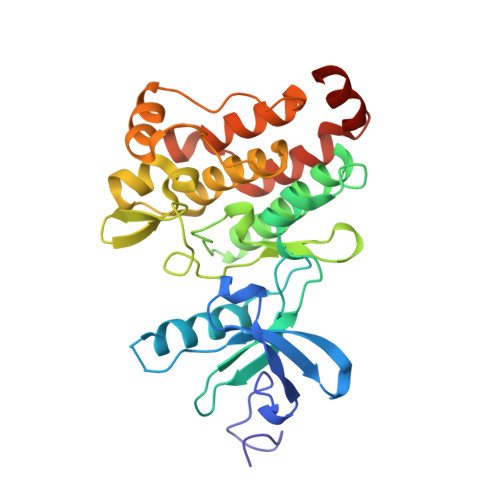Discovery of Asciminib (ABL001), an Allosteric Inhibitor of the Tyrosine Kinase Activity of BCR-ABL1.
Schoepfer, J., Jahnke, W., Berellini, G., Buonamici, S., Cotesta, S., Cowan-Jacob, S.W., Dodd, S., Drueckes, P., Fabbro, D., Gabriel, T., Groell, J.M., Grotzfeld, R.M., Hassan, A.Q., Henry, C., Iyer, V., Jones, D., Lombardo, F., Loo, A., Manley, P.W., Pelle, X., Rummel, G., Salem, B., Warmuth, M., Wylie, A.A., Zoller, T., Marzinzik, A.L., Furet, P.(2018) J Med Chem 61: 8120-8135
- PubMed: 30137981
- DOI: https://doi.org/10.1021/acs.jmedchem.8b01040
- Primary Citation of Related Structures:
6HD4, 6HD6 - PubMed Abstract:
Chronic myelogenous leukemia (CML) arises from the constitutive activity of the BCR-ABL1 oncoprotein. Tyrosine kinase inhibitors (TKIs) that target the ATP-binding site have transformed CML into a chronic manageable disease. However, some patients develop drug resistance due to ATP-site mutations impeding drug binding. We describe the discovery of asciminib (ABL001), the first allosteric BCR-ABL1 inhibitor to reach the clinic. Asciminib binds to the myristate pocket of BCR-ABL1 and maintains activity against TKI-resistant ATP-site mutations. Although resistance can emerge due to myristate-site mutations, these are sensitive to ATP-competitive inhibitors so that combinations of asciminib with ATP-competitive TKIs suppress the emergence of resistance. Fragment-based screening using NMR and X-ray yielded ligands for the myristate pocket. An NMR-based conformational assay guided the transformation of these inactive ligands into ABL1 inhibitors. Further structure-based optimization for potency, physicochemical, pharmacokinetic, and drug-like properties, culminated in asciminib, which is currently undergoing clinical studies in CML patients.
Organizational Affiliation:
Novartis Institutes for BioMedical Research, Novartis Campus , CH-4056 Basel , Switzerland.


















